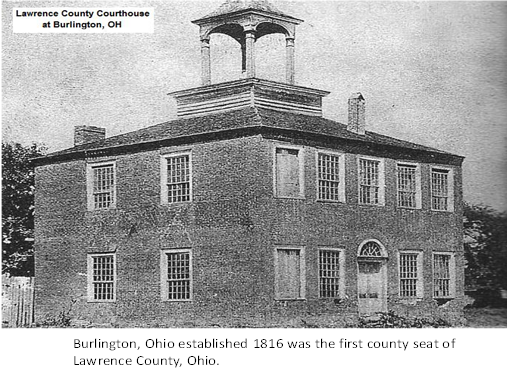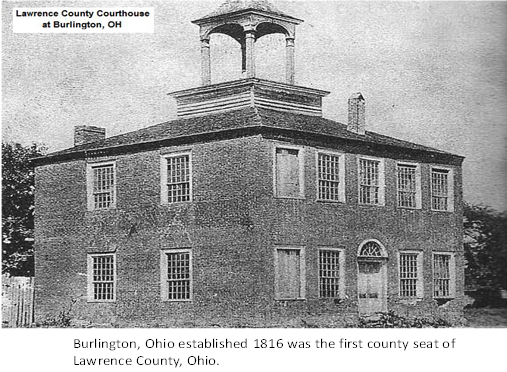THE FIRST COURT HISTORY IN LAWRENCE COUNTY, OHIO SESSION WAS HELD IN BURLINGTON RESIDENCE
Ironton Evening Tribune, Saturday, October 8, 1949 (Centennial Edition)

Lawrence County, Ohio’s judicial system goes back to March 14, 1817, when the first Court of Common Pleas met at Joseph Davidson’s house in Burlington.
From 1803 to 1816, Lawrence county, Ohio, as it is now known, was included in old Washington, which included the country from the Scioto Valley to the Pennsylvania state line; Adams county, which later stripped off a small section of the township of Elizabeth and passed it over to Scioto county, and Gallia county, which embraced all of its territories with that trifling exception.
Lawrence county became a geographic unit by the legislative act of December 20, 1816, which fixed its present boundaries. It was named in honor of Captain James Lawrence, a naval officer in the War of 1812.
February 18, 1817, the general assembly by resolution appointed Judge John W. Campbell and Moses Baird of Adams county and John Barr of Pickaway county as commissioners to fix the seat of the new county, and as Burlington was then the only settlement in the county limits, there was no choice in the matter. So on March 14 that year, the Common Pleas Court met as outlined above. At that time, the county’s population was 665, and its only postmaster Thomas Kerr of Burlington.
The first Common Pleas judges were John Davidson, William Miller, and Gabriel Kerr. John Kelley was appointed temporary sheriff and W. G. Robinson clerk and recorder, while N. The court named K. Clough as prosecuting attorney. Three or more judges served under district assignment for Lawrence, Scioto, Pike, and Adams counties.
John Thompson, president of the court for the second district, presided at the session here on July 7, 1817. The first grand jury included Edward Billups, foreman; Nathaniel Morrison, Augustus Smith, Elisha Hall, John Lunsford, Thomas Singer, Joshua Imes, Adam Farley, Charles McCoy, William Bruce, Richard Sumpter, Daniel Laffoon, Edward Miller, John Billups, and Peter Lineberger, Jr. The expenses incurred by the grand jury amounted to $47.
John O. Ladley, David Cartwell, John M. McConnell, and John R. Cheatwood were admitted to the bar at this court session.
The Lawrence County Bar and Library association was incorporated in February 1911. Five years later, it had a membership of 23. Judge James Collier today is president of the association by virtue of his office, and Elliott E. Meyers is secretary.
The city of Ironton had only a mayor’s court until January 1, 1920, when the city manager’s form of government became effective. The council elected a chairman who also served as a police judge. Dr. W. F. Marting was the first chairman and police judge, followed by C. E. Mayne, Dr. O. H. Henniger, and George Hugger.
The Ironton Municipal Court was established on January 1, 1944, by an act of the legislature, and John J. Gallagher has been a municipal judge since that time.
When Common Pleas Court became a separate county institution, about 1912, the late Judge E. E. Corn became the county’s first judge. He was succeeded by A. J. Layne, Fred Roberts, Ezra Dean, Dan C. Jones, and the incumbent Judge James Collier, who is starting his third consecutive term.
Among Lawrence Countians who served on the district court bench was Judge Johnson, who resides in what is now the Furlong property on Center street. He has been described as “hard-boiled” and is reputed to have sent a man to jail for contempt when he failed to heed a court summons, even though floodwaters blocked entry into the city.


0 Comments